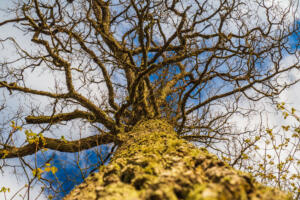
When your tree stands bare in the middle of your yard, it’s easy to wonder—is it still alive or is it time to let it go? In New Jersey, especially after a long winter or harsh storm season, we get this question all the time. At Big Foot Tree Service, we’ve seen plenty of trees that look like they’ve given up—only to bounce back stronger than ever in spring. We’ve also seen trees that looked “just a little slow” but were, unfortunately, too far gone.
So how can you tell what’s really going on with your tree? Let’s break it down.

Dormant vs. Dead: Why It’s So Hard to Tell
Trees go dormant to survive colder seasons. It’s like a deep sleep—no leaves, no flowers, no new growth. But dead trees can look almost the same. The key is knowing what to look for beneath the surface.
Try the Bend-and-Snap Test
Grab a small twig or branch from the tree and gently bend it. If it bends without breaking and still feels moist inside, it’s probably alive. If it snaps right off and is dry or brittle, that part of the tree is likely dead. Try this test in different areas—don’t base your decision on just one branch.
What’s Under the Bark?
A quick scratch with your fingernail or a pocketknife can tell you a lot. If the layer under the bark is green and moist, your tree is still kicking. If it’s brown, dry, or grayish, you could be looking at a bigger issue. This test works best on smaller limbs and branches, not the trunk.
Look at What’s Happening (or Not Happening) Up Top
As the weather warms up, you should see small buds forming. No leaves yet? That’s okay—but no buds at all by mid- to late-spring is a red flag. If the other trees in your neighborhood are greening up and yours is doing nothing, that’s not a great sign.
Watch for Fungal Growth or Decay
Look around the base of the tree. If you spot mushrooms, soft spots, or areas that seem to be rotting, the roots might be in trouble. A dead or dying root system often leads to instability or decay in the entire tree—and unfortunately, it’s not something you can fix by pruning or watering.
Bark Tells a Story
Healthy trees might shed bark, but they usually replace it. If you see large chunks of missing bark or spots where the tree looks dry, cracked, or sunken in, those are signs of declining health. Sometimes this kind of damage starts at the trunk and spreads outward.
Still Not Sure? We’ll Take a Look
You don’t have to guess. At Big Foot Tree Service, we know trees—what’s normal, what’s not, and what needs attention right away. If you’re unsure whether your tree is just resting or needs to be removed, give us a call. We offer free estimates and honest opinions based on years of experience working with trees in Northern New Jersey.
Call Big Foot Tree Service today at 973-885-8000 to schedule a tree health check.
We’re fully licensed, insured, and certified with the State Board of Tree Experts in New Jersey. Whether you need a second opinion or emergency tree removal, we’re just one call away—and always happy to help.









Recent Comments